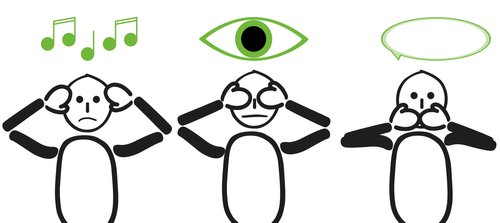

I vividly remember the first time I heard a high resolution file. It was a 24/96 download from HDtracks.com of Vivaldi’s Spring played by violinist Anne Akiko Meyers. It sounded amazing. But it got me thinking: was the better sound really due to the hi-res format or, rather, to the quality of the recording itself? To find the answer, I bought the CD of the same recording and did an AB comparison with the hi-res file. The result? Not even close. The 24/96 version sounded noticeably better, with more transparency and depth.
Still, I wasn’t convinced. Wondering if the result of the test wasn’t a case of sighted bias, I decided to do a blind test to settle the matter. I enlisted the help of my son, who, via my Mac Mini-Audirvana-Wyred 4 Sound digital front end switched surreptitiously and at random between the two files—I ripped the CD into a 16/44 file—and I picked one of them as the better sounding one. And my pick was, indeed, the 24-bit version, at which point I concluded, with 100% certainty, that high-resolution mattered. With my mind incontrovertibly made up, I went on a 24-bit file buying spree.
Fast forward two years, when, on a whim, I decided to do another AB test. And, again, one of the files sounded significantly better than the other. I had no doubt. Except this time, the file I chose was the 16-bit version. Oh, no! I suddenly felt a crack in my belief system. So I repeated, more-or-less, the same tests with different recordings, only to decide that I couldn’t reliably tell apart 24-bit from 16-bit. I got the resolutions right about half the time—as if I’d just guessed the answers!
A few months ago, PMA Magazine conducted a public AB blind test on the 24/96 playback format, for which I prepared and supplied the test files. The test wasn’t even 24-bit against 16-bit but 24-bit against the wildly disparaged mp3 format. Participants were asked, in essence, to choose the 24-bit file. The result? The 24-bit was chosen correctly about 53% of the time. That means 47% of the answers were wrong. This is coin-toss territory. If we can’t reliably tell 24-bit from mp3, how can we ever do so with 16-bit? So I reached the opposite conclusion: high-resolution doesn’t matter.

But time has again passed. I’m smarter now. I learned something valuable about hi-res. I’m convinced that it does matter, just maybe not in the way most of us think. 24-bit matters in two essential ways:
The Recording Format
The Mastering
Here’s why they matter:
The Recording Format (for digital recordings)
Simply put, today’s 24-bit digital recording sounds vastly superior to yesterday’s digital recording which was done mostly in 16-bit. Compare 100 tracks recorded in 24-bit to 100 tracks in 16-bit, and I’m convinced that the higher-res team will beat the lower-res one by significantly more than a crap-shoot result of 53%. If you compare a handful of the recordings made in the last 15 years, during which the use of 24-bit recording technology has become standard, to those made in the mid- to late- eighties, you should be able to hear a clear difference.
Most professional engineers will tell you that you’re unlikely to hear a difference between 16-bit and 24-bit as the playback format. But the same engineers will also tell you that there’s a substantial difference in sound quality between 16-bit and 24-bit when it’s used in the recording, mixing, and processing stages. Using 24-bit simply makes their job easier in a number of ways that affect a recording, one of which is to bring down its noise floor. In other words, for 24-bit to sound noticeably better than mp3 or 16-bit, it can’t just be tacked on at the end of the recording process, but there at the start of it.

The Mastering (for analog recordings)
Mastering is the process of putting the finishing touches on a recording to enhance or alter its sound. What happens at this stage is a lot more critical to sound quality than the consumer’s playback chain. The effect isn’t subtle. Depending on who masters it, the same recording can end up sounding glorious or unlistenable. Digital mastering offers many advantages over analog mastering, but it also offers more opportunities for engineers to objectively harm the sound (“let’s make it as loud as possible… at all cost”, is one good example).
With older analog recordings of which I own both the CD rip and the 24-bit file, I often find the 24-bit sounds better because of the difference in remastering. And I can clearly see they were mastered differently by looking at their waveforms on a computer screen using Audacity software. Of course, remastering being a human job, it could go the other way and the CD version could win. But I don’t see that happening very often. Usually, the 24-bit wins or it’s a tie. Apparently, mastering engineers have learned a lot from their previous mistakes and gotten better and better at their job.
The results of the blind tests I conducted personally, and those of PMA Magazine’s own tests, lead me to believe that 24-bit as the playback format offers little advantage over 16-bit. Yet, you’ll run into many instances where the 24-bit file sounds better than the CD rip because it was simply mastered better. For a consumer, that could be reason enough to choose the 24-bit version.
As for the hardware side of things, my opinion is that all the best-sounding DACs today are capable of 24-bit playback. If one truly believes there’s no benefit to having a DAC that can play back 24-bit files, there’s always the possibility of getting a good sounding DAC for less money that omits 24-bit playback. To me, though, that would be a bit like buying a car without the passenger-side door because I live alone and don’t share my car with anyone; just because I don’t need that door doesn’t mean I want to live without it.










Leave a Reply